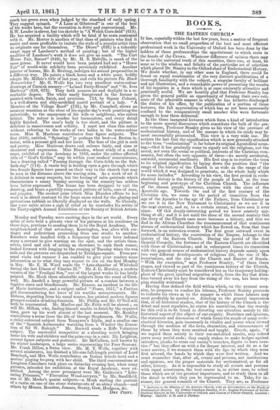fin .51rto.
SOCIETY OF BRITISH ARTISTS.
SxcoND Noxicz.
TEE first picture which calls for remark in the smith-west room, is a pre-Raphaelite specimen by Mr. J. Lee (413), "Sailors taking leave of their Sweethearts and Wives," previous to embarking on board ship. The parting is not very affecting; the sailors bid farewell with a stoicism which would be unnatural if the women had the slightest claim to prettiness of feature; but though their indifference may be forgiven, it is impossible not to condemn their taste. The execution, as Tar as can be seen in its elevated position, is careful and pains- taking; the sky and harbour well painted ; the faces, as mere faces, are good, but all the figures are galvanised; there is no spontaneity, no unity, no centre of action. Mr. Lidderdale is one of the large tribe of domestic painters. His subjects do not display invention, but he always works to the best of his ability. He has two well- meaning pictures (168 and 555). "A Flower Girl from Vier- landen, ' by Mr. P. Levin (495), is pretty and picturesque in her quaint dress and straw hat. "Rouge et Noir" (513), a sweep and a shoeblack chasing each other round a lamp-post, by Mr. A. Ludovici, is a disgrace to the painter of the pretty head I spoke of some weeks ago at the British Institution. To be original is a matter of difficulty to Mr. J. T. Lucas. His "Light of Other Days" (521), a watchman sleeping in his box, looks like direct plagiarism. It is almost identical in composition and material with a picture of the same subject exhibited two or three years back at the Portland Gallery by Mr. Marks. "Shiplake Lock on the Thames" (535), by Mr. W. J.. Ferguson, though hung too high for accurate inspection, seems truthful in colour and less mannered than former works from the same hand. The name of Mr. Banks as a landscape painter is new to me. His "Bed of a Stream on Locton Moor" (539,
) is one
of those literal transcripts from nature that may lead to goo things, if he have imagination as well as fidelity of eye. The lane scenes and river views of Mr. Gosling have a certain air of reality about them, but he has peculiar ideas of colour. His grass and foliage are much too green even when judged by the standard of early spring. They suggest spinach. "A Lane at Gibstrood" is one of the best of his works here, but the execution is dotty and conventional. Mr. B.W. Leader is clever, but too sketch), in "A Welch Corn-field" (615). He has acquired a facility which will be fatal if he rests contented with it. Mr. Hortor is another of that class of painters who find it easier and more profitable to imitate the style of a popular artist than to originate one for themselves. "The Drove" (626) is a tolerably exact cppy of Landseer's method of painting ; but of the higher qualities of Landseees work it does not give us much. "The Cart Horse Fair, Barnet" (849), by Mr. H. S. Melville, is much of the same genus. It never would have been painted had not a "Horse Fair" of world-wide celebrity been previously exhibited. Another painter of horses, Mr. B. Herring, indulges his animal propensities in a different way. He paints a black horse and a white pony, boldly adopts Mr. Millais's title of last year, and calls his picture The Black Brunswicker! Mr. G. Wolfe has two very excellent water-colour drawings of Cornish scenery—" Leland Ferry-House" and "St. Ives Harbour" (659, 673). They both possess air and daylight in a re- markable degree. The white sandy foreground in the former is painted with truth, finish, and precision. 12, by Signor Colucci, is a well-drawn and ably-modelled pastel portrait of a lady. "A Member of the Village Band" (735), by Mr. Campbell, shows an amateur musician at the close of his regular day's work practising the ophecleide, to the annoyance of his wife or neighbour, who enters behind. The colour is sombre but harmonious, and every detail highly finished. The BMA'S body is too short, and the picture is deficient in massiveness and solidity. I must not close this notice without referring to the works of two ladies in the water-colour room. Miss E. Macirone contributes four figure subjects. The first (648), entitled, "Spinning," is perhaps the best—a Breton in- terior, with a peasant girl and her lover. The face of the girl is arch and pretty. Miss Macirone draws and colours fairly, and aims at character and expression. Miss Blunden, whose study of a rocky coast, exhibited at the Academy in 1859, under the rather affected title of " God's Gothic," may be within your readers' remembrance, has a drawing called "Passing through the Corn-fields on the Sab- bath-day" (714). A rustic boy is holding open a gate through which two female figures have passed on their way to the church that may be seen in the distance above the waving corn. As a work of art it is deficient in many respects, but the feeling of calm quietude which characterizes a sunny Sunday morning in the country has seldom been better expressed. The frame has been designed to suit the drawing, and bears a prettily composed pattern of bells, ears of corn, and poppies. The modest price which Miss Blunden affixes 'to her work is in direct contrast to the large sums asked for the glaring and pretentious rubbish so liberally displayed on the walls. So liberally, that your critic utters a sigh of relief as he concludes his notice of the Thirty-eighth Annual Exhibition of the Society of British Artists.































 Previous page
Previous page